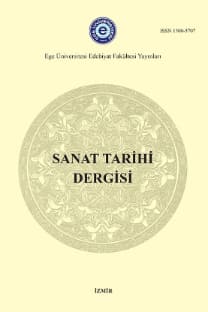Ödemiş Müzesinden Bir Grup I.Iustınıanos ve II. Iustınos Dönemi Sikkesi
İmparatorlar I. Iustinianos ve II. Iustinos dönemleri sikke sistemi, birimler ve birbirleri ile olan ilişkilerinden bahsetmeden önce, bu dönemlerin ekonomik ve politik durumlarından bahsetmeyi tercih ettim. Her ne kadar imparator I. Iustinianos döneminde Nika isyanı ve 200 yıldan fazla süren korkunç veba salgını gibi bazı yıkıcı olaylar gerçekleşmiş olsa bile, Bizans tarihinde Bizans’ın ‘İlk Altın Çağı’ olarak hatırlanmıştır. Yurttaşlık Yasası Derlemesi olan Corpus Iuris Civilis kanunu hukuken kabul edilmiş ve 532-37 yılları arasında Aya Sofya inşa edilmiştir. İmparator I. Iustinianos dönemi sikke sisteminde yer alan altın ve bakır sikke birimlerinden dönemi çerçevesinde bahsedilmiştir. Yanı sıra, birimler ve darphaneler arasındaki ilişkiler kısaca hatırlatılmıştır. Bunlara ek olarak, Hıristiyan inancı ve ideoloji etkisi ile sikke sistemine getirilen ikonografik değişiklikler de ortaya çıkmıştır. Her ne kadar, Roma imparatorluk portre sanatı, yaklaşık olarak daima profil portreler yada büstler formundadır, bu dönemde de hala Bizans nümismatik sanatında devam etmiş olsa bile, cephe figürler kullanılmaya başlanmıştır ve bu tasvir biçimi Bizans nümismatik sanatında standart imparatorluk portre tipi haline gelmiştir. 538/9 yılları arasında imparator I. Iustinianos’un bakır sikke birimlerinde ilk defa imparatorun saltanat yılı darp edilmiştir. Bakır sikke birimlerinin arka yüz değer işaretinin sağ boşluğuna Latin alfabesinde harfler ile basılmıştır. İmparator I. Iustinianos döneminde sikke tiplerine, ikonografisine ve birimlerine bir takım değişiklikler getirilmiştir. Bu değişiklikler I. Iustinianos döneminden sonra da devam etmiştir. II. Iustinos’un dönemi ise imparator I. Iustinianos döneminin hem ideolojik, hem de imparatorluk politikası olarak devamı olmuştur. Ödemiş Müzesinde bulunan tanıttığım sekiz sikkeden iki tanesini altın solidus, bir tanesini altın tremissis; dört tanesini bakır follis ve bir tanesini de yarım follis oluşturmaktadır. Bu sikkelerin tarihlendirilmesinde bazı farklılıklar tespit etmiş bulunmaktayım. Bu sikkelere doğru birer tarihlendirme yapabilmek için Bizans nümismatiğine ilişkin katalogları araştırarak, makale arkasında yer alan bir katalog ile tanıtmayı uygun bulmaktayım.
Anahtar Kelimeler:
-
A Group of Coins From Ödemiş Museum Belonging to Iustinianos I and Iustinos II Period
I prefered to introduce the economic and political life of the reign of the emperors Iustinianos I. and Iustinos II. before talking about the coinage system, denominations and the relations with each other. Although the reign of the emperor Iustinianos I. was affected by some disastrous events like Nika revolt and the catastrophic plague which continued more than two hundred years, it was mentioned as a ‘first golden age’ in Byzantine history. The Corpus Iuris Civilis was promulgated and also Hagia Sophia was built in 532-37. Coinages from the reign of the emperor Iustinianos I. which contains gold and copper denominations were regarded on the base of this period. Also relations of denominations and mints were mentioned briefly. In addition to these, some changes in the iconography of coinages occured with the affect of the Christian belief and ideology. Although Roman imperial portraiture, almost always taking the form of profile heads or busts, still continued in numismatic art of Byzantine Empire at that time, facing figures were started to be used and it became a standard Byzantine imperial portraiture type in Byzantine numismatic art. The emperor’s year of the reign in coins’ inscriptions was firstly appeared in the copper denominations of the emperor Iustinianos I. in 538-39. On the right side of the reverse of the copper denominations had the year of the emperor’s reign in Latin alphabetical letters. The reign of the emperor Iustinianos I. brought some changes on the types, iconography and the denominations of coinages. These changes also were survived after the end of the emperor Iustinianos I.’s reign. The reign of the emperor Iustinos II. was the continuation of the emperor Iustinianos I.’s reign in both ideology and the imperial policy. I introduced eight coins which were located in Ödemiş Museum; two of them were solidus, one of them was tremissis and four of them were copper denomination follis and one of them was half follis. I found differences about their times. I researched Byzantine numismatic catalogues to give them the true dates of minting. At the end of this article a catalogue of the above mentioned coins were presented.
Keywords:
-,
- ISSN: 1300-5707
- Yayın Aralığı: Yılda 2 Sayı
- Başlangıç: 1982
- Yayıncı: Ege Üniversitesi, Edebiyat Fakültesi
Sayıdaki Diğer Makaleler
Erken Hristiyan Cam Sanatında Altın Yaldız Bezeme
Mykale (Samson) Dağında Çınarlı Kilise Adını Verdiğimiz Bir Manastır Kilisesi
Ödemiş Müzesinden Bir Grup I.Iustınıanos ve II. Iustınos Dönemi Sikkesi
Rahmi Hüseyin ÜNAL, Aydoğan DEMİR
Bizans Dönemi Fantastik Kurgulu Betimleme Taşıyan Yeni Bir Seramik Obje
